
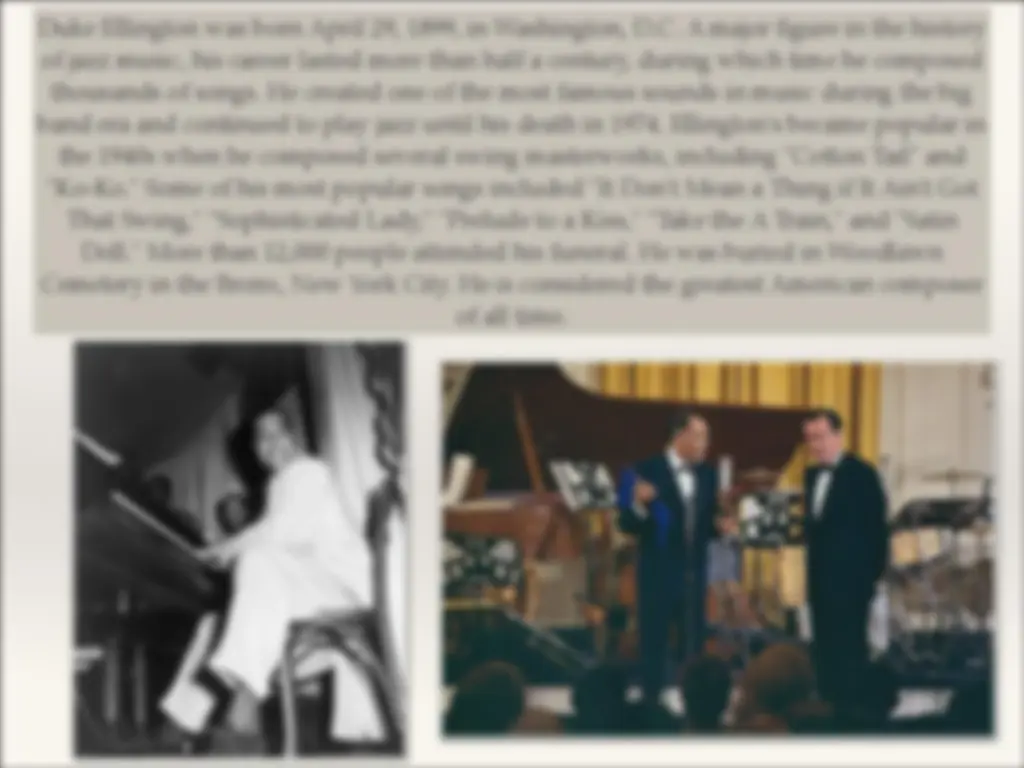
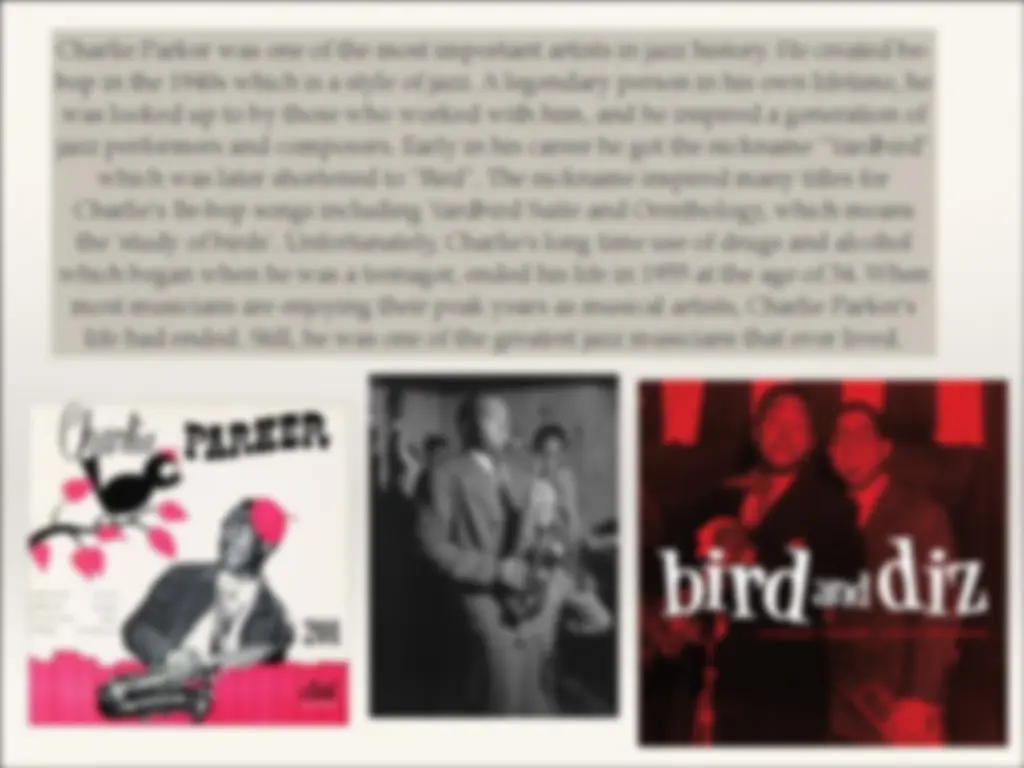
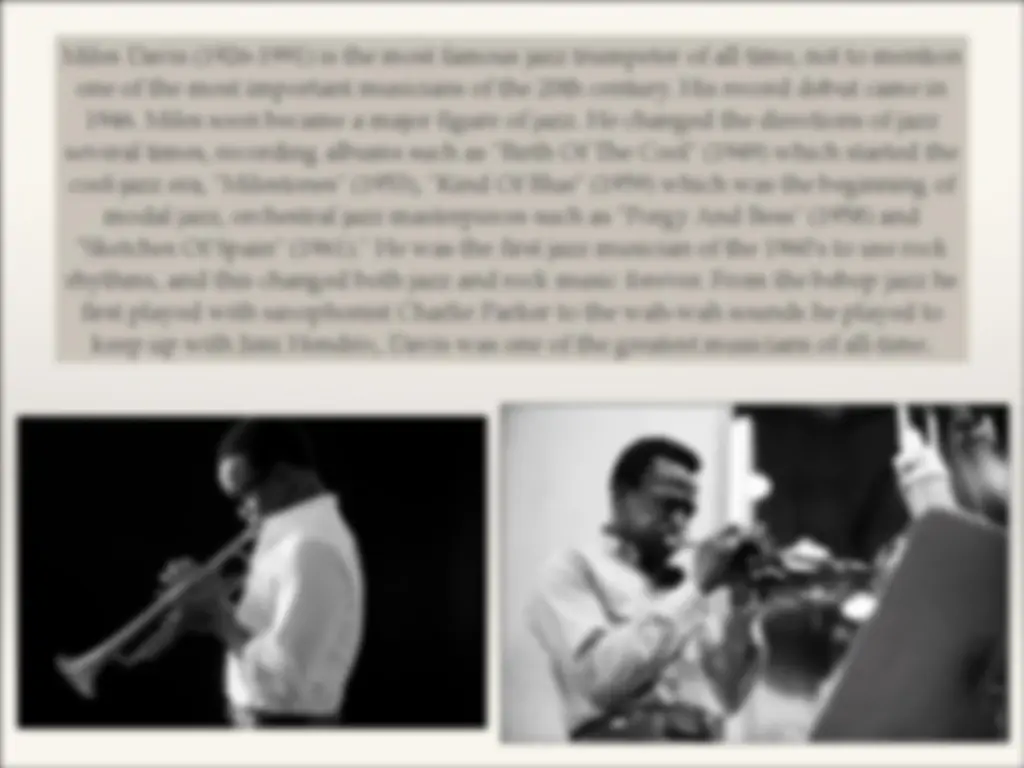
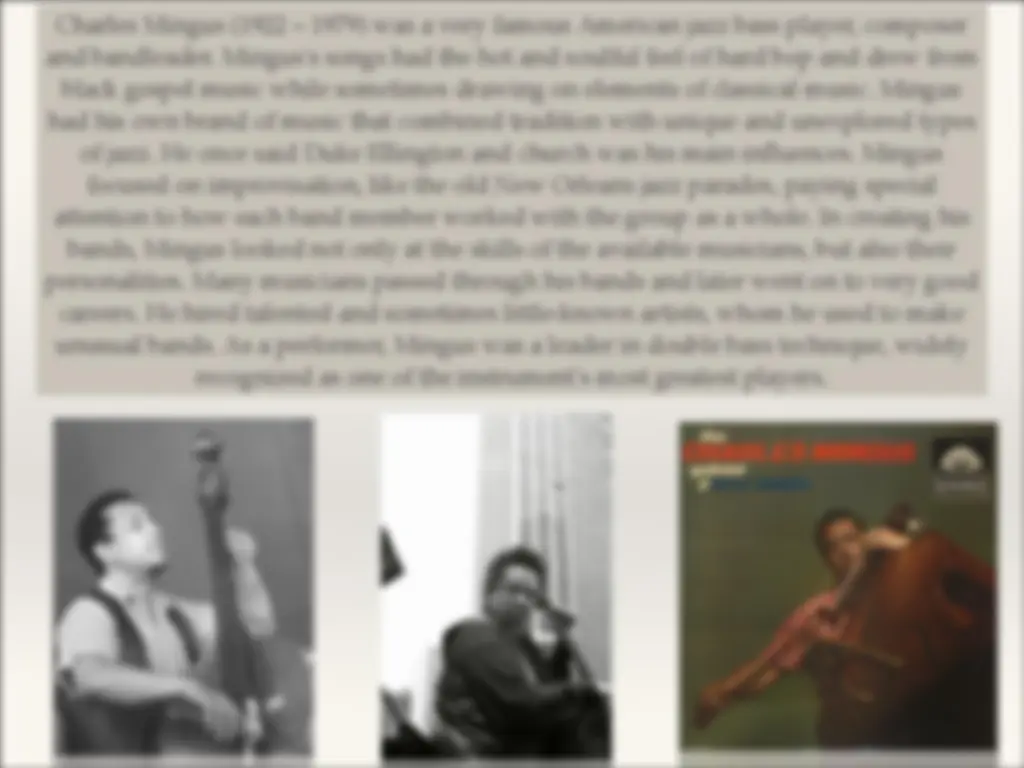
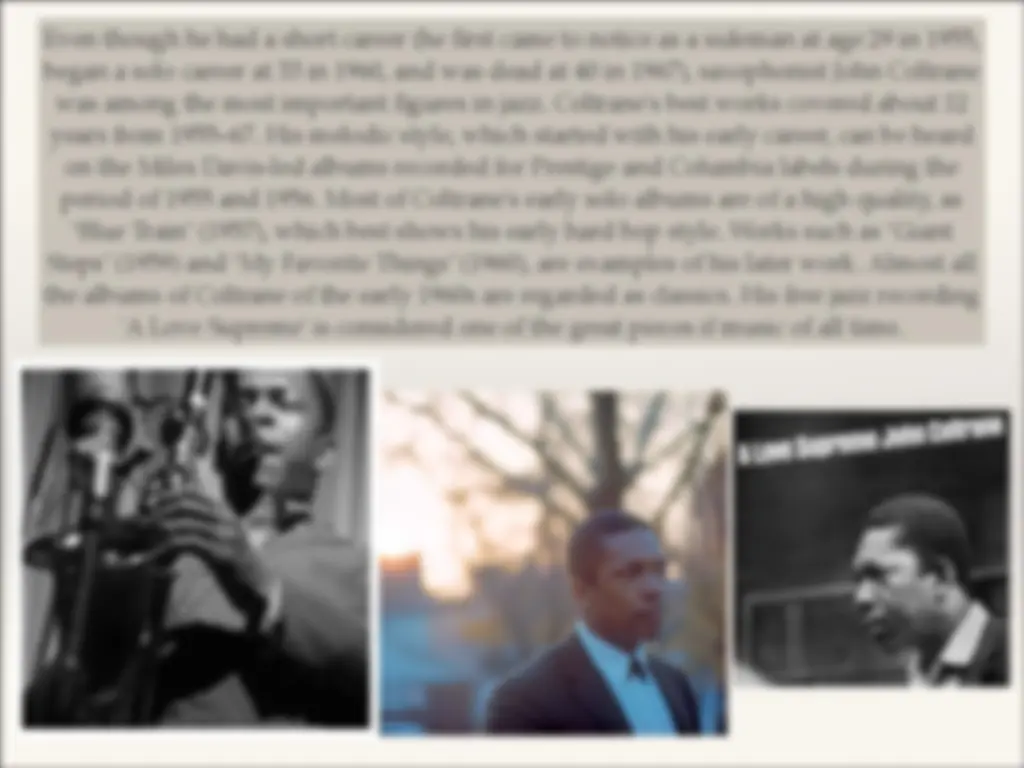
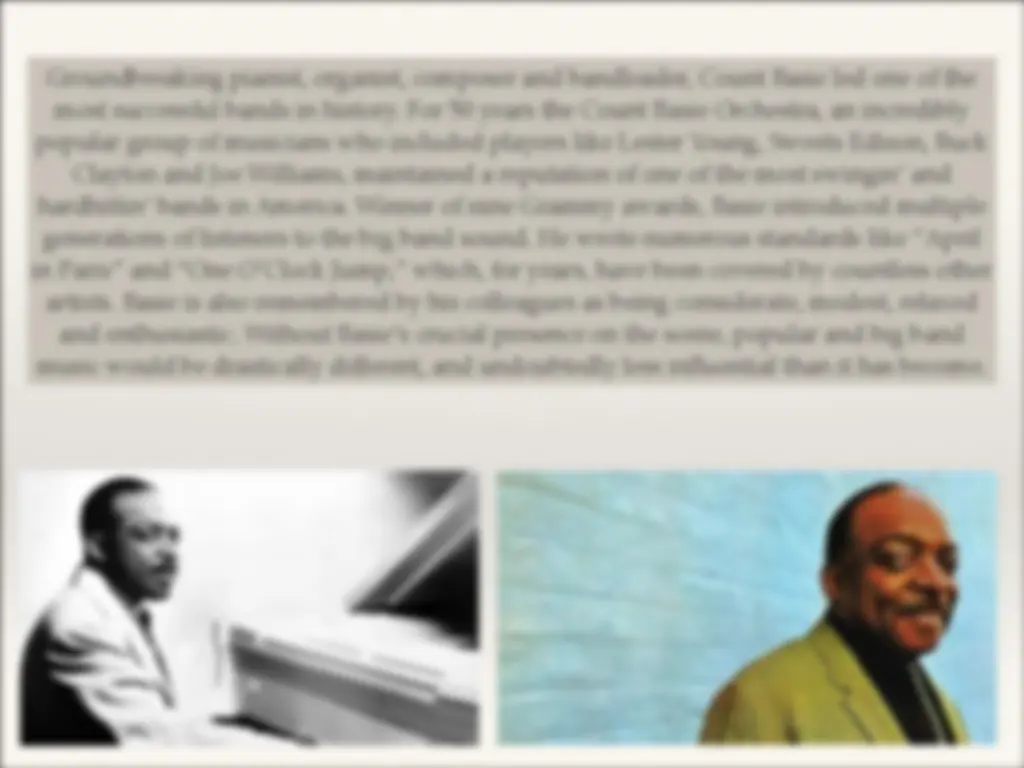
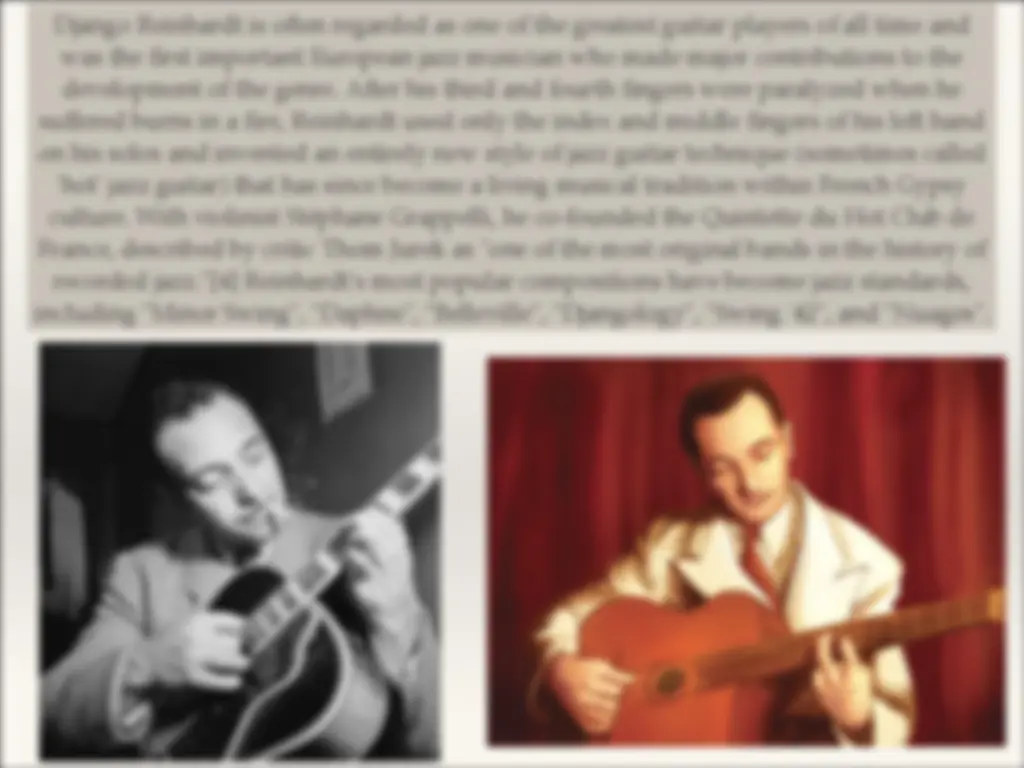
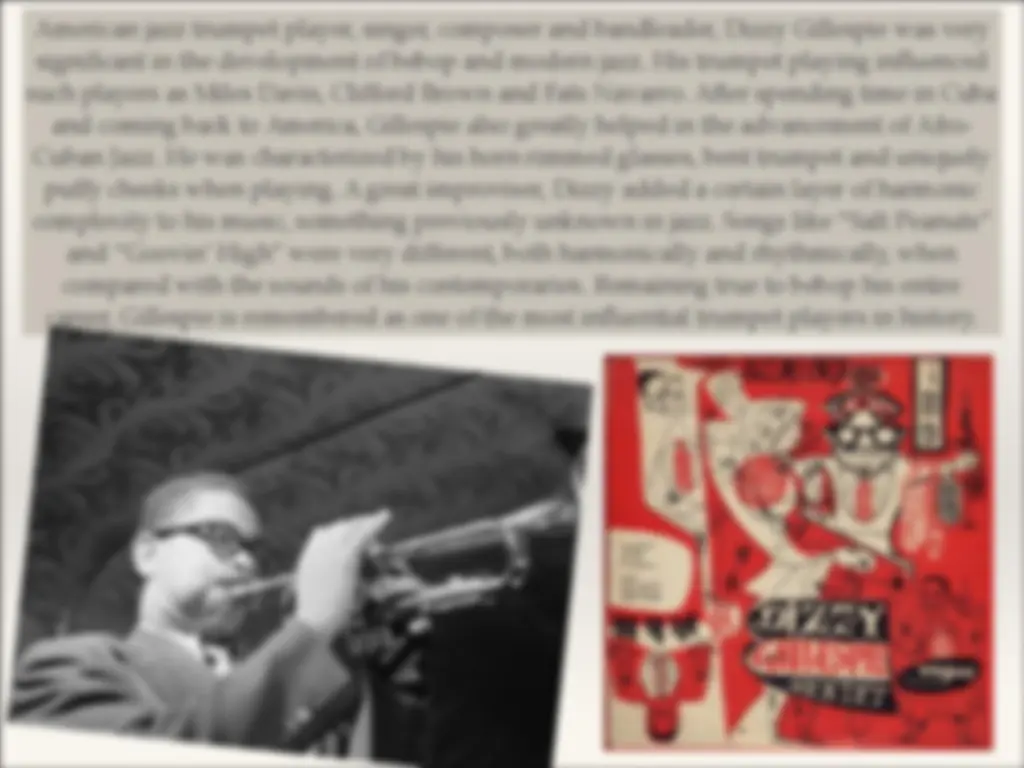
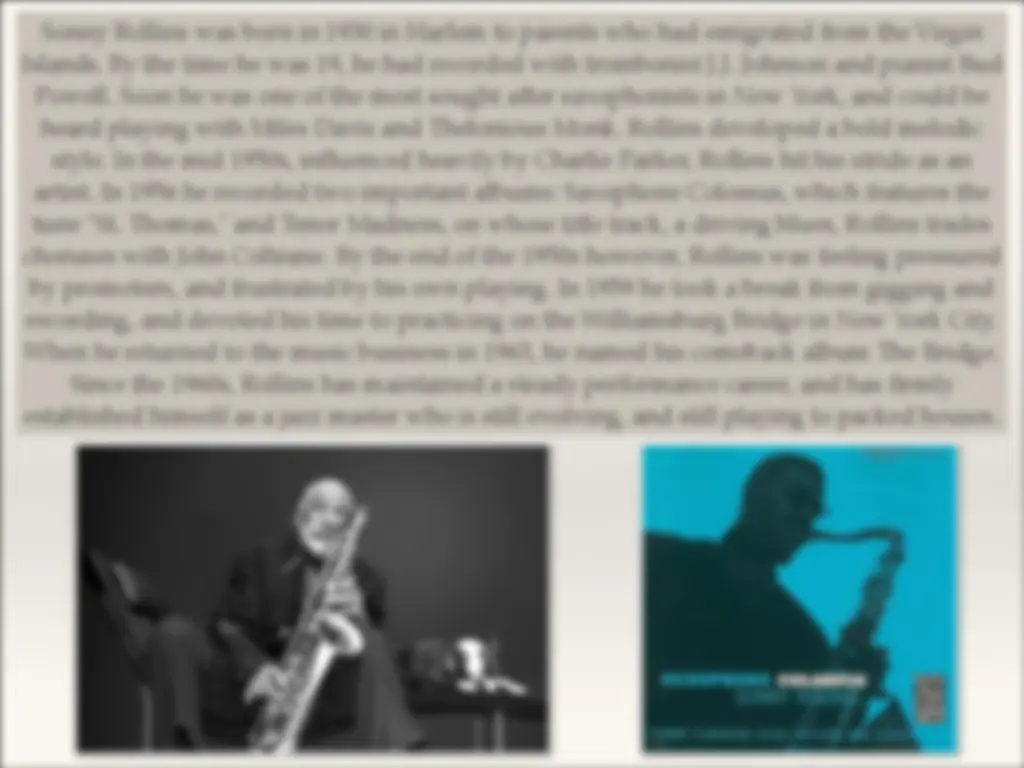


Study with the several resources on Docsity

Earn points by helping other students or get them with a premium plan


Prepare for your exams
Study with the several resources on Docsity

Earn points to download
Earn points by helping other students or get them with a premium plan
Community
Ask the community for help and clear up your study doubts
Discover the best universities in your country according to Docsity users
Free resources
Download our free guides on studying techniques, anxiety management strategies, and thesis advice from Docsity tutors
An overview of jazz music, its origins in the African-American communities of the Southern United States, and its evolution into various styles. It highlights the contributions of influential jazz artists such as Louis Armstrong, Duke Ellington, Charlie Parker, Miles Davis, Thelonious Monk, Dave Brubeck, and Django Reinhardt.
Typology: Lecture notes
1 / 15

This page cannot be seen from the preview
Don't miss anything!










Jazz is a music genre that started in the early 1900's or earlier, within the African-American communities of the Southern United States. It combines African rhythms and European harmony to create a new African American art form. It combines blues, improvisation, polyrhythms, syncopation and dance. Jazz also has elements from popular music especially, in its early days, from American popular music. As the music developed and spread around the world it has split into many styles: New Orleans jazz dating from the early 1910s, big band swing, Kansas City jazz and Gypsy jazz from the 1930s and 1940s, bebop from the mid-1940s on down through Afro-Cuban jazz, West Coast jazz, ska jazz, cool jazz, avant-garde jazz, soul jazz, Latin jazz in various forms, smooth jazz, jazz fusion and jazz rock, jazz funk, acid jazz, and other ways of playing the music.
Louis Armstrong (1901-1971) was the greatest of all Jazz musicians. Armstrong defined what it was to play jazz. Like almost all early jazz musicians, Louis was from New Orleans. He was from a very poor family and was sent to reform school when he was twelve. He loved music and his favorite artist was Joe "King" Oliver. When he was older King Oliver gave him his first real cornet, and even gave him lessons. In 1922 Louis joined Oliver's Creole Jazz Band in Chicago. His playing in the band soon made him very well known. By 1925 he formed his own band, Louis Armstrong's Hot Five and Hot Seven. There recordings are considered jazz classics and are some of the greatest of all time. Louis Armstrong would record and play music for the rest of his life. His influence on jazz and American culture makes him one of the most important American artists ever.
Charlie Parker was one of the most important artists in jazz history. He created be- bop in the 1940s which is a style of jazz. A legendary person in his own lifetime, he was looked up to by those who worked with him, and he inspired a generation of jazz performers and composers. Early in his career he got the nickname "Yardbird" which was later shortened to "Bird". The nickname inspired many titles for Charlie's Be-bop songs including Yardbird Suite and Ornithology, which means the 'study of birds'. Unfortunately, Charlie's long time use of drugs and alcohol which began when he was a teenager, ended his life in 1955 at the age of 34. When most musicians are enjoying their peak years as musical artists, Charlie Parker's life had ended. Still, he was one of the greatest jazz musicians that ever lived.
Miles Davis (1926-1991) is the most famous jazz trumpeter of all time, not to mention one of the most important musicians of the 20th century. His record debut came in
Dave Brubeck (1920 –2012) was an American jazz pianist and composer best known for helping create cool jazz. He wrote a number of jazz standards, including "In Your Own Sweet Way" and "The Duke". Brubeck used many styles in his music, reflecting his mother's attempts at classical training and his improvisational skills. His music is known for using unusual time signatures over different rhythms, meters, and tonalities. His long-time musical partner, alto saxophonist Paul Desmond, wrote the saxophone melody for the Dave Brubeck Quartet's best remembered piece, "Take Five", which is in 5/4 time and has endured as a jazz classic on one of the top-selling jazz albums, Time Out. He was also a respected composer of orchestral and sacred music, and wrote soundtracks for television such as Mr. Broadway and the animated miniseries This Is America, Charlie Brown.
Charles Mingus (1922 – 1979) was a very famous American jazz bass player, composer and bandleader. Mingus's songs had the hot and soulful feel of hard bop and drew from black gospel music while sometimes drawing on elements of classical music. Mingus had his own brand of music that combined tradition with unique and unexplored types of jazz. He once said Duke Ellington and church was his main influences. Mingus focused on improvisation, like the old New Orleans jazz parades, paying special attention to how each band member worked with the group as a whole. In creating his bands, Mingus looked not only at the skills of the available musicians, but also their personalities. Many musicians passed through his bands and later went on to very good careers. He hired talented and sometimes little-known artists, whom he used to make unusual bands. As a performer, Mingus was a leader in double bass technique, widely recognized as one of the instrument's most greatest players.
Groundbreaking pianist, organist, composer and bandleader, Count Basie led one of the most successful bands in history. For 50 years the Count Basie Orchestra, an incredibly popular group of musicians who included players like Lester Young, Sweets Edison, Buck Clayton and Joe Williams, maintained a reputation of one of the most swingin’ and hardhittin’ bands in America. Winner of nine Grammy awards, Basie introduced multiple generations of listeners to the big band sound. He wrote numerous standards like “April in Paris” and “One O’Clock Jump,” which, for years, have been covered by countless other artists. Basie is also remembered by his colleagues as being considerate, modest, relaxed and enthusiastic. Without Basie’s crucial presence on the scene, popular and big band music would be drastically different, and undoubtedly less influential than it has become.
“Lady Day” was perhaps the most exceptional popular music singer of the 20th century. She wrote few songs, but when she sang, she took on a deep, personal and intimate approach. Her vocal style and intonation was inspired greatly by the sound of the instruments she heard and was filled with a profound intensity. In that manner, she developed a new style, incorporating the manipulation of phrasing and tempo. Her recording of the song “Strange Fruit” is considered one of the most important songs in history, because of it’s powerful theme and topic, and because of Holiday’s powerful performance. She received multiple posthumous Grammy Hall of Fame awards and Grammy Best Historic Album awards for her work. Although her delivery may have been somewhat thin and her range fairly limited, there is no doubt that her voice was more powerful than any at the time could have hoped to be.
Django Reinhardt is often regarded as one of the greatest guitar players of all time and was the first important European jazz musician who made major contributions to the development of the genre. After his third and fourth fingers were paralyzed when he suffered burns in a fire, Reinhardt used only the index and middle fingers of his left hand on his solos and invented an entirely new style of jazz guitar technique (sometimes called 'hot' jazz guitar) that has since become a living musical tradition within French Gypsy culture. With violinist Stéphane Grappelli, he co-founded the Quintette du Hot Club de France, described by critic Thom Jurek as "one of the most original bands in the history of recorded jazz."[4] Reinhardt's most popular compositions have become jazz standards, including "Minor Swing", "Daphne", "Belleville", "Djangology", "Swing '42", and "Nuages".
American jazz trumpet player, singer, composer and bandleader, Dizzy Gillespie was very significant in the development of bebop and modern jazz. His trumpet playing influenced such players as Miles Davis, Clifford Brown and Fats Navarro. After spending time in Cuba and coming back to America, Gillespie also greatly helped in the advancement of Afro- Cuban Jazz. He was characterized by his horn rimmed glasses, bent trumpet and uniquely puffy cheeks when playing. A great improviser, Dizzy added a certain layer of harmonic complexity to his music, something previously unknown in jazz. Songs like “Salt Peanuts” and “Goovin’ High” were very different, both harmonically and rhythmically, when compared with the sounds of his contemporaries. Remaining true to bebop his entire career, Gillespie is remembered as one of the most influential trumpet players in history.